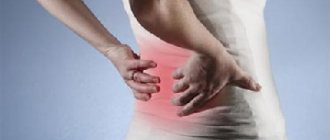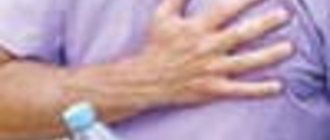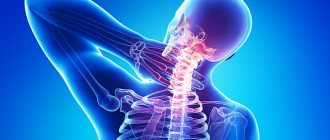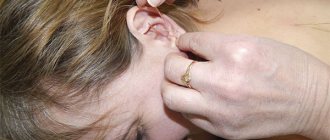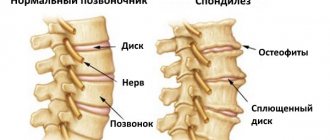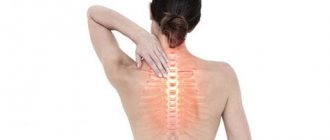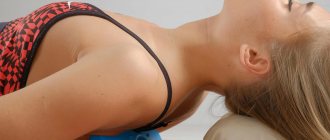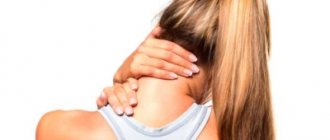It is possible to find out the exact cause of pain in the thoracic spine only after diagnosis, since the symptoms of many pathologies are very similar. So, pain can be caused by a banal muscle strain or a serious disease of the spine, lungs, heart, and possibly oncology. In order for treatment to be as successful as possible, it is advisable to identify the cause of pain as early as possible and begin to undergo appropriate therapy.
Nature of pain in the thoracic region
Pathological changes in the thoracic region can be identified if chest pain occurs with:
- Tilts of the body to the sides;
- Lifting significant weight;
- Inhale and exhale deeply.
- Weak, squeezing pain occurs when the spine is compressed and nerve endings are pressed.
Nagging, aching pain in the thoracic region is most often caused by various infectious diseases.
If the pain is acute and does not stop for a long period, this may be a signal of the presence of malignant tumors. In addition, acute chest pain often indicates diabetes, vasculitis (inflammation of blood vessels), shingles and other herpetic infections. Unbearable pain is often a sign of spondyloarthrosis, a form of osteoarthritis that is characterized by damage to cartilage tissue.
Other features of the symptoms of osteochondrosis of the thoracic spine
With osteochondrosis of the thoracic region, gastrological syndrome is often observed, which is often defined as a disease of the gastrointestinal tract. The main complaint of patients who often turn to a gastroenterologist is pain in the epigastric region, which, as a rule, intensifies in the afternoon after physical work and subsides (or completely disappears) after a full night's rest. Its appearance and intensification are practically unrelated to seasonality (as is known, in true patients with gastritis and peptic ulcers, autumn and spring rarely pass without serious exacerbations), food quality, and diet. These features of the manifestation of the syndrome help to establish the correct diagnosis.
With osteochondrosis, the intervertebral discs at the level of the 7-11th vertebrae suffer, the pain - sometimes strong, paroxysmal, sometimes dull, aching - spreads to the right hypochondrium. During an attack, patients are often admitted to the hospital with a variety of diagnoses: acute calculous cholecystitis, kidney prolapse, pancreatitis, colitis, urolithiasis. And only as a result of a detailed medical examination is it possible to make the correct diagnosis - osteochondrosis of the thoracic spine.
Vascular disorders caused by osteochondrosis can be suspected if the skin peels off for no apparent reason, the nails become very brittle, and the feet often feel chilly.
Often, osteochondrosis of the thoracic spine is complicated by intercostal neuralgia. Pain along the ribs extends to the sternum. Any movement increases the discomfort, including coughing, sneezing, even inhaling. Occasionally, pain may be felt in the anterior abdominal wall. An attack of intercostal neuralgia caused by thoracic osteochondrosis can last from several hours to several weeks. It can go away without treatment, but later long-term relapses occur. Provoking factors for such an attack of intercostal neuralgia can be heavy lifting, prolonged uncomfortable posture, hypothermia, colds and stress.
Cause of pain
Together with the ribs, the thoracic spine forms a strong frame designed to support and protect the heart and lungs from damage. The small height of the intervertebral discs in combination with the spinous processes of the vertebrae makes this part of the spine rigid and practically immobile.
Unpleasant sensations or pain in the thoracic region can be caused by:
- Trauma. When the ribs or spine are injured, severe pain occurs when turning the body, while coughing or sneezing. Literally any, even seemingly minor, injury to the spine has a high probability of causing damage to the spinal cord. And in especially difficult cases it can lead to paralysis;
- Pathology of the heart, lungs, and gastrointestinal tract. In this case, severe chronic pain occurs;
- Osteoporosis, scoliosis, spondyloarthrosis, kyphosis, kyphoscoliosis and other pathologies of the spine;
- Tuberculosis and polio.
- In addition, one of the most common causes of chronic chest pain in older people is sciatica.
Causes
Let's look at the main causes of pain in the thoracic vertebrae:
- spinal pathology - scoliosis, osteochondrosis, disc herniation (rarely) and protrusion, myositis;
- back injuries - chest bruises and vertebral fractures (including osteoporosis), sprains;
- neurology - intercostal neuralgia, severe stress or prolonged depression;
- diseases of other organs - pancreatitis, stomach ulcers, heart disease, pneumonia/pleurisy, kidney stones;
- infections - tuberculous spondylitis, herpes zoster;
- malignant neoplasms - cancer or metastases in the lungs and mediastinum, oncopathology of the stomach, etc.
Diagnostics
There are many pathologies and their symptoms are very similar. Therefore, it is possible to determine the exact cause of pain in the thoracic region only after a thorough diagnosis. Sometimes the pain can be caused by a simple muscle strain, but most often the cause of pain is lung disease, heart disease or spinal disease. In order for the treatment to be as successful as possible, it is necessary to determine the cause of the unpleasant sensations, and then begin appropriate therapy.
Diagnostics takes place in several stages:
First, the patient describes in detail the nature of the pain. Based on this description, the doctor determines the cause - pain can occur due to pathology of the spine or diseases of the lungs, heart and internal organs;
The doctor conducts a comprehensive examination of the patient, analyzes the general condition of the musculoskeletal system, and examines the thoracic region. Afterwards, a computed tomography, x-ray or MRI is prescribed. Treatment is prescribed only after studying the results of all tests performed.
Back pain in the spinal area: epidemiological significance of the symptom
People often complain of back pain in the spinal region. Statistics say that about 70-80% of people experience at least one episode of such pain during their lives. Therefore, this is an unusually pressing medical problem.
Therefore, medical statistics have collected a large amount of epidemiological data about this symptom. It is known that 40-80% of people experience back pain in the lower part of the spine. The percentage of patients seeking help for pain in the thoracic and cervical regions is somewhat lower.
In 10-20% of patients of working age, acute pain in the spine transforms into chronic pain. It is this category of patients that often has an unfavorable prognosis for complete recovery, so that healthcare costs for treating people of working age with chronic back pain in the spinal region account for about 80% of all funds aimed at treating this symptom.
Causes
The most commonly observed are so-called nonspecific back pain associated with muscle strain caused by uncomfortable posture or stereotypic movements. Often the trigger for the occurrence of such pain is hypothermia. As a rule, nonspecific back pain disappears within 1-3 months after its occurrence. However, in 10-30% of cases, the pain syndrome recurs throughout the year, and in 10% of patients, nonspecific back pain becomes chronic.
The second most common cause of back pain in the spinal region is radiculopathy - damage to the nerve root at the point where it exits the spinal canal. Radiculopathy syndrome accompanies many spinal lesions, the most common of which is osteochondrosis.
Less commonly, back pain in the spinal area is caused by direct damage to the spinal column.
The most common spinal pathologies that cause back pain are:
- osteochondrosis;
- injuries (bruises, fractures, dislocations or subluxations of the vertebrae, torn ligaments, etc.);
- hormonal spondylopathy (menopausal, postmenopausal and senile);
- tuberculous spondylitis;
- ankylosing spondylitis (Bechterew-Strumpel-Pierre Marie disease)
And finally, back pain in the spinal area may indicate damage to many internal organs. In such cases, the pain syndrome radiates along the nerve fibers, and the radiating pain can be stronger than the primary one, and even mask it.
Irradiation of back pain to the spinal region most often occurs in the following pathologies:
- damage to the heart and great vessels (angina pectoris, myocardial infarction, dissecting aortic aneurysm);
- lung diseases (pleurisy, malignant neoplasms);
- liver diseases (acute and chronic cholecystitis);
- lesions of the esophagus;
- diseases of the pancreas (acute and chronic pancreatitis, pancreatic cancer);
- kidney and upper urinary tract diseases.
Thus, back pain in the spinal area may indicate diseases of various organs and systems, so even experienced doctors who have all the achievements of modern medicine in their arsenal sometimes find it difficult to make a diagnosis.
In order to resolve the issue of the cause of back pain in the spinal region, you should first of all know the main syndromes accompanying lesions of the spinal column.
Causes of pain in the back and spine - video
Back pain due to damage to the spine. Main syndromes of vascular and neurological disorders
Spinal column and its parts: structure and functions
To understand the mechanism of development of vascular and neurological disorders in spinal lesions, it is necessary to know its basic anatomical and physiological features.
The spinal column is an elastic connection of the vertebrae, providing several vital functions at once:
- the main axis that gives the body stability and mobility;
- a spring that guarantees shock absorption to all tissues and organs during movement;
- the receptacle of the spinal cord and the conductor of nerve fibers from the center to the periphery;
- protection for part of the vessels supplying the brain.
The spine consists of five sections, each of which has its own functional characteristics:
- Cervical.
- Chest.
- Lumbar.
- Sacral.
- Coccygeal
The structure of the upper spine is more fragile and thin. The function of nerves and blood vessels here prevails over the function of support and shock absorption.
Downwards the vertebrae become more and more massive. So the five sacral vertebrae form a single bone - the sacrum.
The main functions of the sacral region are to provide support and participate in the creation of the pelvis - a protective container for internal organs. The coccyx, consisting of five fused vertebrae, is a rudiment of the tail, and its participation in the work of the spinal column is minimal.
Therefore, lesions of the sacral and coccygeal spine cause pain in the lower spine in the sacral region, but are not accompanied by severe vascular and neurological disorders characteristic of the pathology of the upper sections.
The cervical, thoracic and lumbar regions consist of separate vertebrae - seven, twelve and five, respectively. The structure of all vertebrae, except the first and second cervical ones, is the same - there is a body located in front and a vertebral arch that limits the spinal canal at the back.
The vertebral bodies are connected to each other by intervertebral discs, which give the spinal column strength and elasticity at the same time. The fact is that each intervertebral disc has a nucleus pulposus inside, capable of elastic compression. Therefore, the spine is often compared to a spring.
Additional mobility of the spinal column is given by joints formed by the paired articular surfaces of adjacent vertebrae.
The entire structure is reinforced with a powerful ligamentous apparatus. In addition, the back muscles, which are a kind of corset for the spine, play an important protective and supporting role. Therefore, people suffering from back pain due to spinal damage are advised to perform exercises that develop the back muscles.
The mechanism of development of vascular and neurological disorders in spinal lesions
Pain from spinal injury is often accompanied by neurological disorders associated either with damage to the nerve roots leaving the spinal canal at the level of injury, or with damage to the spinal cord, or with circulatory disorders in the spinal cord caused by pinched vessels in the affected area.
Nerve roots pass through the openings between the vertebral bodies and supply certain parts of the body - segments. Therefore, by the localization of neurological disorders, the level of damage to the spine can be determined.
Regardless of the level of damage to the spinal column (cervical, thoracic or lumbar), damage to the nerve roots is characterized by the following features of the pain syndrome:
- shooting character;
- distribution along the course of innervation along the segment;
- increased by coughing, sneezing, sudden movements in the affected part of the spine;
- night pain.
In addition to pain, radicular syndrome is characterized by symptoms of disruption of the basic functions of the radicular nerves in the corresponding areas:
- Sensory disturbances (crawling sensation, decreased sensitivity up to complete anesthesia).
- Movement disorders (muscle weakness, paralysis).
- Trophic disorders (hypotrophy and atrophy of tissues, development of degenerative changes in joints, etc.).
Damage to the spinal cord is manifested by the development of paralysis and loss of sensitivity below the level of the lesion. Such disorders are most typical for lesions of the cervical and thoracic spine. At the level of the first lumbar vertebra, the spinal cord passes into the filum terminale, accompanied by a bundle of nerve fibers (the so-called cauda equina).
The spinal canal also contains blood vessels that supply the brain and accompany the spinal roots, therefore, in case of damage to the upper parts of the spine, disturbances in the blood supply to the tissues may be evident.
Damage to the spine in the cervical region
Increased lability and relative vulnerability of the cervical spine causes a high incidence of injury (whiplash fractures of motorists, diver injuries, etc.). Often, the consequences of a seemingly minor spinal injury will remind you throughout your life of headaches.
However, the most common cause of pain in the cervical spine is osteochondrosis and other degenerative changes in the spine. Tumors and congenital anomalies of the structure of the spinal column are less common.
Pain in the cervical spine caused by damage to the spinal column may be accompanied by:
- Compression of the spinal cord with total paralysis of the limbs, and impaired sensitivity below the level of the lesion;
- Circulatory disorders of the brain;
- Radicular syndrome.
Severe damage to the spinal cord at the level of the cervical vertebrae, as a rule, occurs with spinal injuries, and leads to paralysis of the diaphragm and disruption of the functioning of vital internal organs, which often leads to death.
The development of vascular insufficiency of the brain is characteristic of chronic degenerative lesions of the spine. The causes of circulatory disorders in such cases are indicated by the connection between headaches and other symptoms with movements in the cervical spine, or prolonged static load (uncomfortable head posture, including during sleep).
The most typical symptoms are:
- headache;
- fainting;
- visual disturbances (flickering flashes, etc.);
- cochleovestibular pathology (tinnitus, slight persistent hearing loss, rotational vertigo);
- laryngopharyngeal symptoms (impaired swallowing, choking, cough, sometimes perversion of taste);
- changes in the mental sphere (sleep disturbances, tearfulness, irritability, sometimes hysteria).
Pain caused by radicular syndrome in the cervical spine, as a rule, radiates from the cervical spine through the shoulder girdle, and further along the outer surface of the shoulder.
The most common injuries are to the lower cervical spine. In this case, the irradiation of pain reaches the fingers. The pain is accompanied by sensory disturbances in the same segment, and paresthesia in the most distant places of pain irradiation. The weakness of the innervated muscles (biceps or triceps) is pronounced, and their hypotrophy develops over time.
Damage to the thoracic spine
Pain with damage to the thoracic spine is extremely rarely accompanied by radicular syndrome. The fact is that the displacement of the vertebrae is prevented by a physiological corset of ribs.
However, quite often with some diseases of the spine, for example, with ankylosing spondylitis, pain occurs in the chest area, which is very similar in nature to radicular pain.
In such cases, pain is associated with damage to the small joints of the spine connecting individual vertebrae with the ribs (costovertebral and costotransverse joints). In this case, there is a sharp pain in the region of the costovertebral joints (at a distance of half a finger from the spinous processes of the spine). An additional symptom is pain when pressing on the ribs in the affected segments.
Compression of the spinal cord as a result of pathology of the thoracic spine is also rare. Damage to the spinal cord in the area of the thoracic vertebrae is manifested by paralysis of the lower extremities, impaired sensitivity below the area of damage, delayed passage of feces and urine, as well as trophic disorders in the lower half of the body and lower extremities.
Most often, compression damage to the spinal cord in the thoracic region develops with severe spinal injuries (including gunshots) and oncological pathology. In case of traumatic injury, compression syndrome develops acutely, in case of spinal tumors it develops gradually.
Spinal circulation disorders caused by pathology of the thoracic spine can occur both acutely and chronically.
However, regardless of the cause, the development of symptoms of severe spinal cord damage in the thoracic spine is an alarming symptom that requires medical intervention.
Pain in the lumbar spine. Lumbar syndromes
Pain in the lower part of the spine with damage to the lumbar region with the development of radicular and compression syndromes, as well as vascular insufficiency syndrome of the spinal cord.
Due to the heavy load and lack of rib protection, the lumbar region is most often affected. This is a favorite place for spinal disc herniations and displacement of individual vertebrae.
Radicular syndrome is the main and most striking sign of damage to the lumbar spine. Lesions of the last lumbar vertebrae are typical.
As a rule, a clear picture of compression of the nerve roots in the lumbar region develops after periods of “lumbago”, and is characterized by severe pain in the area of the affected vertebra with irradiation into the buttock, down the outer edge of the thigh to the anterior outer surface of the leg, and then to the foot to the toes. In this case, the localization of radiating pain in the toes (mainly in the first or fifth toe) has diagnostic significance for determining the level of damage.
Compression of the cauda equina is manifested by severe pain spreading to both legs, disturbances in the acts of defecation and urination, loss of sensitivity in the anogenital zone and on the inner thighs like “rider’s pants.”
Circulatory disorders of the spinal cord with damage to the lumbar spine are quite common, and in typical cases they manifest themselves as pain in the leg and lower back, as well as weakness of the foot.
Sharp pain in the lower spine with characteristic irradiation in reflex lumbar syndromes.
With lesions of the lumbar spine, radicular syndrome is very common, but pain of a reflex nature is even more common. In this case, a sharp pain that occurs acutely is called lumbago, and a chronic pain is called lumbodynia.
In both cases, sharp pain in the lower spine with characteristic irradiation to the lower extremities occurs reflexively, due to irritation of the receptors of the fibrous ring of the affected disc, joints and ligaments of the spine.
A typical attack of lumbago occurs in an inclined position of the body, most often while lifting something heavy. Acute pain in the lower spine is usually shooting in nature (“lumbago”); it is very strong, bursting. Patients say: “It’s as if a knife was stuck in the lower back.” So the patient cannot straighten up, and any attempt to move, cough or sneeze greatly increases the pain, causing the patient to freeze in one place.
With lumbago, natural immobilization of the affected segment occurs, which is manifested by smoothing of lumbar lordosis (the natural anterior curve of the spine), and often scoliosis (curvature of the spine).
Lumbodynia occurs, as a rule, after awkward movement, physical overexertion or hypothermia. However, unlike lumbago, it develops over several hours or days. The pain is not so sharp and may intensify when standing or sitting, especially when changing body position.
The deformity of the lumbar region in this case is less pronounced. with intense palpation of the spinous vertebrae, one can identify particular pain in the area of the affected segment.
Pain in the spine due to osteochondrosis
Osteochondrosis is the most common cause of back pain caused by damage to the spinal column. About 95% of patients seeking treatment for neck or lower back pain suffer from osteochondrosis.
The causes and mechanism of development of this pathology are still not fully understood. Some researchers consider osteochondrosis to be a natural result of the aging of the body, which, in the presence of certain genetic defects (hereditary predisposition), occurs ahead of time. Physical inactivity or, conversely, heavy physical labor associated with frequent bending and heavy lifting contribute to the development of osteochondrosis.
To understand the essence of the pain syndrome in osteochondrosis, it is necessary to know the mechanism of development of the pathology. At the first preclinical stage of the disease, degenerative processes occur in the intervertebral disc, leading to displacement of the nucleus pulposus. As a result, the stability of the spinal segment is disrupted.
At the second stage, the instability of the spinal segment is compensated by reactive changes in the bodies of adjacent vertebrae, as well as in their joints and ligaments. At this stage, radicular symptoms appear, and sometimes signs of impaired blood supply, or compression of the spinal cord.
At the next, third stage, an intervertebral disc ruptures, often with the formation of a spinal hernia. And finally, the fourth stage is characterized by the pathological process extending beyond the intervertebral disc.
The most characteristic of osteochondrosis is dyscalgia - acute pain in the spine caused by degenerative changes in the intervertebral disc. Dyscalgia is characterized by spread along the nerves of the affected segment and the addition of radicular symptoms (motor, sensory and trophic disorders).
It should be noted that the symptoms of osteochondrosis are polymorphic. Radicular pain is often accompanied by a pain syndrome caused by overstrain of the muscles that support the spinal column. Constant muscle hypertonicity, in turn, leads to compression of nerves and blood vessels by overstrained muscles, and the appearance of corresponding symptoms.
Thus, with osteochondrosis of the cervical spine, scalene muscle syndrome occurs, manifested by characteristic symptoms of compression of the subclavian artery and brachial plexus (swelling and pain in the arm, worsening in a horizontal position, decreased sensitivity and motor disturbances in the area of innervation of the ulnar nerve). By the same mechanism, piriformis syndrome occurs, manifested by symptoms of damage to the sciatic nerve compressed by the muscle (pain and trophic disorders in the lower leg and foot).
A very common symptom of spinal osteochondrosis is visceral pain. Particularly characteristic are dull aching pains in the heart that occur with osteochondrosis of the cervical spine. Another typical sign of damage to this part of the spine is headaches and other signs of impaired blood circulation in the brain.
A characteristic feature of visceral pain, regardless of its location, is the occurrence or intensification during movements, or prolonged static load on the affected part of the spine.
All of the pain syndromes described above will help to correctly diagnose and determine the location of the affected segment.
Spinal hernia
A herniated disc is usually a consequence of osteochondrosis. The impetus for the occurrence of pathology is any awkward movement or excessive physical effort. The most typical history: acute pain in the spine that occurred after lifting heavy objects. Statistics show that most often a herniated disc occurs during the holiday period, during travel that involves heavy lifting. This is why some researchers call spinal hernia a “suitcase disease.”
Pain from a herniated spine intensifies with movement, coughing, and sneezing. In cases of damage to the lumbar spine, pain often occurs when straining during bowel movements. The pain syndrome is often one-sided, so in the case of a typical lumbar hernia it is necessary to carry out a differential diagnosis with kidney damage.
Most often, spinal hernias occur in the lumbar region, less often in the cervical region, and extremely rarely in the thoracic region. Among the complications of spinal hernias is the development of spinal cord compression syndrome with the development of paralysis and sensory impairment below the site of the lesion. Spinal cord circulatory disorders caused by compression of blood vessels are often encountered.
Spinal fracture
The nature of pain from a spinal fracture depends on its type. Thus, with isolated fractures of the spinous processes of the spine, localized pain occurs in the fracture zone, and fractures of the transverse processes are characterized by pain radiating to the sides along the ribs.
In case of vertebral body fractures, the pain syndrome depends on the degree of stability of the fracture. For example, sometimes stable fractures of the vertebral bodies are practically asymptomatic and heal on their own. In severe cases, against the background of severe pain, signs of spinal cord compression develop, requiring immediate surgical intervention.
Aching and nagging pain in the spine due to spondyloarthrosis
Spondyloarthrosis is a disease of the small joints of the spine, belonging to the group of arthritic diathesis. It is often combined with other hereditary disorders - atherosclerosis, obesity, diabetes.
Pain in the spine with spondyloarthrosis is of an uncertain nature, intensifies after periods of prolonged immobility (in the morning, after severe illnesses with bed rest, etc.), with injury, hypothermia, after an infectious disease.
With a long course of the disease, reactive growth of bone tissue occurs, leading to a narrowing of the openings through which the spinal nerves pass. In such cases, radicular syndrome develops.
Severe pain in the spine after sleep with ankylosing spondylitis (Bechterew-Strumpel-Pierre Marie disease)
Pain in the spine with ankylosing spondylitis is in many ways similar to the pain syndrome with spondyloarthrosis, especially morning pain. However, the pain associated with ankylosing spondylitis is more intense; the disease disrupts the ability of patients to work from the very beginning of its development, and quickly leads to immobility of the affected areas of the spine. As a result, a characteristic curvature of the spine occurs (“supplicant pose”).
Ankylosing spondylitis is a systemic disease of connective tissue, predominantly affecting small joints of the spine, so other signs of this group of diseases (increased ESR, low-grade fever, increased fatigue, weight loss, general weakness) will help in diagnosis.
Hormonal spondylopathy (menopausal, postmenopausal and senile)
Pain in the spine with hormonal spondylopathies is caused by degenerative changes in the intervertebral discs and the leaching of calcium from the bones. Spontaneous spinal fractures often occur.
The pain syndrome resembles pain in the spine due to osteochondrosis. But hormonal spondylopathies are characterized by poor posture, increased thoracic kyphosis (in some cases, the costal arch can descend to the pelvic bones), and pain in the bones of the extremities.
Aching, pulling or boring pain in the spine with tuberculous spondylitis
Most often, the tuberculosis process affects the thoracic spine; lumbar localization of the process is less common; tuberculosis of the cervical spine is extremely rare. The disease can develop at any age, most often in the second or third decade of life.
The initial stages of tuberculous spondylitis are asymptomatic, so pain appears even when the process is far advanced.
Characteristic pain in the spine is aching or boring in nature, often radiating to the limbs, aggravated by coughing, sneezing, and flexion-extension movements of the torso. The pain syndrome is accompanied by sensations of tingling, crawling, heat, and pulsation. The pain is constant and can sometimes be relieved by walking.
Pain radiating to the spine
Just as damage to the spine often leads to visceral pain, damage to internal organs often causes pain radiating to the spine. Additional symptoms characteristic of damage to certain organs will help in diagnosis.
Pain in the chest and spine due to pathology of the heart and great vessels. Sharp pain
descending along the spine downward with dissecting aortic aneurysm
Wide irradiation of pain is characteristic of coronary heart disease. Pain in the chest and spine is especially severe during acute myocardial infarction. In this case, the pain is localized behind the sternum, and radiates under the left shoulder blade and into the spine, as well as up along the vessels, into the left supraclavicular region, into the jaw, and down into the left hand, to the little finger.
A dissecting aortic aneurysm is characterized by acute, sudden pain. As a rule, the pain syndrome is first localized behind the sternum, and then moves down along the aorta, and is described by patients as a sharp pain in the middle of the spine.
In typical clinical cases of diseases of the heart and great vessels, differential diagnosis with lesions of the spine will not cause difficulties, since it is possible to determine both the primary localization of pain and additional symptoms characteristic of acute damage to the cardiovascular system (impaired blood pressure and heart rate, cold sweat , fear of death, pallor).
Pain in the spine between the shoulder blades due to gallbladder diseases
Pain in the spine between the shoulder blades is a fairly common symptom of gallbladder damage. In the case of acute cholecystitis, the primary localization of pain can be determined in the right hypochondrium, with irradiation to the right subclavian region, under the right scapula and into the spine.
Difficulties in diagnosis may arise in the chronic course of the disease, since pain in the projection of the gallbladder may be weak or absent. In such cases, help will be provided by detailing the pain syndrome (the occurrence or intensification of pain after eating fatty fried foods, lack of connection with movements in the spine) and the presence of additional signs of damage to the gallbladder (bitterness in the mouth, pain on palpation in the projection area of the gallbladder).
Pain in the abdomen and spine due to lesions of the pancreas
Diseases of the pancreas are characterized by girdling pain in the abdomen and spine. In the case of acute and exacerbations of chronic pancreatitis, differential diagnosis with lesions of the spine is not difficult to carry out, since other signs of damage to the pancreas are clearly visible (the occurrence of pain after eating sweet, fatty foods and/or alcohol, nausea, vomiting that does not bring relief, etc.) .
Severe gnawing pain in the spine at night is specific to cancer of the body and tail of the pancreas. However, pain syndrome appears in the later stages of the disease, when the so-called minor signs of cancer are expressed (weight loss, general weakness of the body, etc.).
Severe pain in the spine and lower back due to pathology of the kidneys and upper urinary tract
With unilateral radicular syndrome in the lumbar region, it is necessary to carry out differential diagnosis with damage to the kidneys and upper urinary tract due to urolithiasis.
The fact is that the pain syndrome in typical renal colic is also characterized by the sudden appearance of severe pain in the spine and lower back.
However, there are times signs that allow you to distinguish these diseases.
Firstly, exacerbation of pain in the lower back and spine during urolithiasis cannot be associated with a sudden change in body position, lifting weights, and other typical factors that provoke an attack of radiculitis.
Secondly, pain from urolithiasis radiates along the ureters to the abdomen, groin area, genitals and inner thigh. Damage to the lumbar spine is characterized by irradiation down and back - to the buttocks, the outer surface of the thigh, up to the lower leg and foot.
Thirdly, with renal colic, patients rush around the room or in bed, while patients with damage to the lumbar spine, on the contrary, freeze in place, since any movement causes excruciating pain.
Treatment for pain in the spine. Answers to the most popular questions
What treatment may be needed for spinal pain? Which doctors should I contact?
In order to correctly prescribe treatment for pain in the spine, it is necessary to undergo a full examination and determine the cause of the pain syndrome.
Back pain in the spinal region may be a consequence of diseases of the internal organs; in such cases, contact the appropriate specialists.
If the pain is caused by damage to the spine, then treatment is prescribed in accordance with the disease and the stage of the pathological process.
The problem of spinal pathologies has recently become so popular that a special branch of medicine has emerged - vertebrology. So in difficult cases they turn to a specialist.
If this is not possible, then most likely you will need the help of two specialists - an orthopedist and a neurologist.
In cases where spinal damage is caused by tuberculosis (tuberculous spondylitis), there will be three attending physicians - a phthisiatrician, an orthopedist and a neurologist.
If pain in the spine is a consequence of menopausal spondylopathy, you may need to consult an endocrinologist.
In case of ankylosing spondylitis, recommendations from a rheumatologist are necessary.
If back pain in the spinal area occurs during pregnancy, consult a antenatal clinic doctor.
How to treat back pain resulting from spinal damage? In what cases is surgical treatment necessary?
There are the following indications for surgery:
- severe constant pain in the spine, resistant to conservative therapy;
- complicated herniation of the intervertebral disc (manifested by persistent radicular syndrome, as well as symptoms of compression of the spinal cord or cauda equina);
- suspicion of unreducible spinal hernia or tumor;
- instability of the spinal segment with a pronounced risk of complications;
- some forms of scoliosis (progressive deformation of the spine in childhood and adolescence).
It should be noted that in each specific case, the issue of surgical treatment is decided individually, taking into account all contraindications to surgery.
Pain appeared after spinal surgery. What to do?
Unfortunately, pain complicates the postoperative period in many patients. In such cases, you should seek advice from the surgeon who performed the operation.
Most often, pain after spinal surgery is caused by the formation of a postoperative scar, and disappears over time. However, in some cases, pain may indicate complications for which reoperation is recommended.
What are the basic principles of conservative treatment of back pain due to spinal lesions? Will exercise help with spinal pain?
The basic principle of any therapy is an individual approach. In the case of back pain caused by damage to the spinal column, not only the nature of the disease is taken into account, but also the stage of the pathological process, as well as the characteristics of the clinical course in this particular patient. In addition, attention is paid to concomitant diseases that may aggravate the pathology or become a contraindication to the use of a particular method of therapy.
Today, for back pain caused by damage to the spine, a gentle regimen is mandatory. In the acute period, maximum caution is prescribed when moving (especially when moving from a horizontal to a vertical position and back, when bending, etc.); during the period of remission, heavy physical labor and heavy lifting are contraindicated.
Drug therapy includes a wide range of drugs. For severe pain in the spine and severe radicular syndrome, novocaine blockade, non-steroidal anti-inflammatory drugs, muscle relaxants and glucocorticoids are used. Often they use products containing elements necessary to restore the spine (Swiss drug Rumalon, German drug Osteochondrin, etc.).
In addition to drug therapy, the following types of conservative treatment are most widely used:
- orthopedic methods (corset, traction in water and other methods of spinal traction);
- manual therapy;
- physiotherapy;
- massage;
- balneophysiotherapy;
- acupuncture (acupuncture).
Almost all methods have their contraindications. So, for example, a contraindication to manual therapy is compression of the spinal cord or cauda equina, and orthopedic traction is contraindicated in cases of intervertebral disc pathology associated with endocrine disorders.
As for physical exercises for pain in the spine, they are strictly contraindicated during the acute period. During remission, physical therapy complexes are prescribed by a specialist and carried out under medical supervision.
How to relieve pain from a spinal hernia?
In severe cases, to relieve severe pain from a spinal hernia, novocaine blockade is used. In the acute period of the disease, rest, drug therapy with drugs from the group of non-steroidal anti-inflammatory drugs and muscle relaxants are necessary, and further observation by a specialist.
How to treat pain in the spine during pregnancy?
The following factors contribute to the development of complications from the spine and the occurrence of pain during pregnancy:
- Increased load on the spine associated with weight gain and uneven distribution.
- Physiological loosening of connective tissue associated with prenatal preparation.
- Forced vertical position of the body (“proud posture of pregnant women”).
Thus, pain in the spine during pregnancy can be caused either by static overstrain of the muscles that hold it, or by spinal pathology that develops during pregnancy. In addition, low back pain may be associated with kidney disease, which can lead to severe complications during pregnancy and childbirth.
So if you experience pain in the spine during pregnancy, you should seek advice from a doctor and, if necessary, undergo additional examination and treatment.
Before use, you should consult a specialist.
Author: Cherednik O.V.
Treatment
The choice of one or another method of treating the spine directly depends on the complexity of the pathology. This can be complex drug treatment, or manual therapy, exercise therapy, or, for example, massage. In most cases, to achieve maximum effect, the doctor prescribes several methods at once.
Drug therapy
Drug treatment involves taking anti-inflammatory and painkillers. To enhance the effect, you can use external means - ointments, creams or rubbing. In a hospital setting, the doctor may prescribe an electrophoresis procedure, which ensures rapid penetration of active substances into the area of the inflammatory process.
Manual therapy
Manual therapy involves treatment using two methods: osteopathy and chiropractic.
Chiropractic treatment involves physical impact on the diseased area of the spine with shocks of varying strength and amplitude. But, this method is contraindicated for wounds, rib fractures, and pathologies of the musculoskeletal system.
Despite the fact that the effectiveness of osteopathy has not yet been proven, some orthopedists and traumatologists continue to use certain techniques of this therapy in their practice. And patients who have undergone a course of osteopathy note a significant improvement in their condition.
Physiotherapy
Physiotherapeutic treatment can begin only after inflammation and pain have subsided. It includes warming, water procedures, and electrical procedures. At this stage, it is recommended to undergo a massage course of 10 or more procedures, depending on the intensity of the pain.
To speed up the rehabilitation process, doctors prescribe a specially designed physical therapy complex; the exercises of the complex must be done under the supervision of a trainer, since any uncomfortable or too sudden movement can only aggravate the problem.
Physiotherapy
Exercise therapy can be preventive or therapeutic. It is often prescribed for the treatment of various diseases of the joints and spine. Indeed, in combination with drug treatment and physiotherapy, it will help you quickly return to normal life.
If the set of exercises is chosen correctly, physical therapy will help not only increase the overall tone of the body, but also strengthen the muscle frame.
Each technique has its own mechanism of action and ensures the achievement of a specific result. The best effect is achieved with complex treatment, when all parts of the pathological process are affected.
Sometimes, after completing the main treatment, the patient may need to undergo a rehabilitation course. Its purpose may be to eliminate residual neurological symptoms and normal mobility of the spine and joints.
Treatment of osteochondrosis of the thoracic spine using the NANOPLAST forte patch
Medicines prescribed for the treatment of spinal osteochondrosis, such as NSAIDs, muscle relaxants, etc., can cause harm to the body when used for a long time. And in the presence of certain diseases of the gastrointestinal tract, many of these drugs are generally contraindicated.
A new generation drug, the therapeutic pain-relieving anti-inflammatory patch NANOPLAST forte, helps to minimize the side effects of drugs and increase the effectiveness of treatment of osteochondrosis.
The therapeutic plaster NANOPLAST forte has shown high effectiveness in the treatment of various diseases of the spine, including the treatment of osteochondrosis of the thoracic region. It allows you to relieve pain and inflammation, improve blood circulation in the affected area, and reduce the dose of painkillers and anti-inflammatory drugs.
To relieve acute symptoms in the treatment of thoracic osteochondrosis of the spine, a therapeutic patch is used for 3 to 5 days. The duration of the course of treatment is from 9 days. It is usually recommended to use the treatment patch in the morning for 12 hours, but it can also be used at night.
High efficiency, unique composition, long-term (up to 12 hours!) therapeutic effects, ease of use and affordable price make NANOPLAST forte the drug of choice in the treatment of osteochondrosis of the thoracic spine.
Read more about NANOPLAST forte
Prevention
Prevention of pain in the thoracic region includes the following recommendations and measures:
- Lifting weights. If you plan to actively engage in sports, then it is better to do this under the supervision of a trainer who will control the technique of performing the exercises. This way you can minimize the load on the spine;
- Morning exercises. Just a few simple exercises that everyone can do will not only provide you with a boost of energy for the whole day, but also a healthy back for many years;
- Warm-up breaks. If your work requires a long period of immobility, then, if possible, you should do a warm-up right at your workplace. Walk around, perform special exercises aimed at stretching the spine;
- Swimming. Swimming is a simple and at the same time quite effective way to tone your back muscles. However, it is worth noting here that if you have problems with the cardiovascular and respiratory systems, visiting the pool is not recommended. Therefore, before you go swimming, be sure to consult your doctor;
- Massage. It can be especially effective if pain in the thoracic region is caused by muscle strain. But, again, before visiting a massage therapist, you should definitely consult a doctor. After all, you may not even suspect that in your particular case, massage is contraindicated;
- Correct position while sleeping. It is advisable to sleep on your side - in this position the spine is as relaxed as possible. An orthopedic mattress and pillow will help minimize the risk of back problems;
- Overweight. This problem is especially acute, because extra pounds significantly increase the load on joints and intervertebral discs. The fight against excess weight does not always mean grueling workouts and fasting. In most cases, a balanced diet will be enough to stay in shape.
Compliance with the above rules will make it possible to enjoy life without ever knowing about the existence of pain in the thoracic region. Remember, if chest pain becomes severe and occurs regularly, it’s time to seek help from a specialized doctor.
Osteochondrosis of the lumbar region
The most common type of osteochondrosis is lumbar osteochondrosis. Pain syndrome is observed in the lumbosacral region with pain spreading to the legs (ischalgia) or localized only in the leg (ischalgia).
The pain, predominantly dull and aching, intensifies with sudden movements and with prolonged forced posture, decreases with a horizontal position of the torso. Atrophy and paresis (loss of sensitivity), decreased reflexes are possible.
Autonomic disorders manifest themselves in the form of dryness and flaking of the skin, impaired sweating and cyanosis of the skin. Static disorders are manifested by flattening of the lumbar lordosis as an adaptive reaction to reduce the range of motion of the spine.
